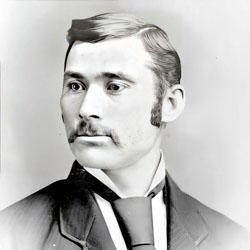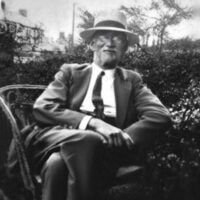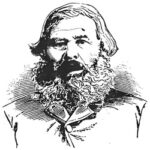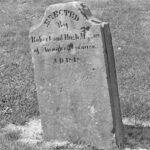Born on July 12th, 1857, in the serene surroundings of Greenock Township, Bruce County, Ontario, Canada, Ainsley Megraw’s story is one of ambition, perseverance and a relentless drive to excel across diverse endeavors – from education and journalism to military service, mining ventures and distinguished community leadership roles. His legacy stands as a testament to the limitless potential of the human spirit when fortified by resilience and an unwavering commitment to personal growth.
Early Years and Education
Ainsley was one of twelve children born to John Megraw and Isabella Wallace, Irish immigrants who settled in Greenock Township after fleeing the Great Famine in Ireland. Growing up in the rustic charm of rural Ontario, the young Ainsley embarked on his academic journey in 1868 or 1869, first attending school in Paisley, Bruce County. The writer of a local history account described him as “a demure little chappie” who sat on a bench that was perhaps a bit too high for his stature. Nevertheless, these formative years laid the foundation for his values of diligence and determination embodied by his immigrant parents.
In December 1879, Ainsley achieved a significant milestone, passing the Professional Examination at the renowned Ottawa Normal School, a prestigious teacher training institute. Earning a 2nd Class Certificate from the Ontario Minister of Education was a remarkable accomplishment for the son of working-class Irish immigrants in that era.
Volunteer Military Service
Ainsley Megraw maintained a lifelong interest in military affairs, which manifested early on through his involvement as a volunteer with the 32nd “Bruce” Battalion of Infantry – a militia battalion formed in September 1866 in Walkerton, drawing volunteer companies from across Bruce County. Ainsley’s exposure began a couple of months earlier when his brother Robert J. Megraw joined a local militia unit mobilized in June 1866 and sent to Goderich, Ontario during the Fenian crisis, likely inspiring Ainsley’s own volunteer military pursuits later in life.
As a volunteer in the 32nd Battalion, Ainsley rose through the ranks of Sergeant by the early 1880s. He continued attending specialized training, earning prestigious certifications with high marks in drill, discipline, and marksmanship. His dedication was recognized with promotions to the ranks of Captain in 1889 and Major in 1895 within the battalion.
While passionate about military affairs through his volunteer service, Ainsley’s true calling lay in engaging his community through the newspaper industry, where his intellectual curiosity and thirst for knowledge found their fullest expression.
A Career in Journalism
In 1884, Ainsley became the co-proprietor of the weekly newspaper The Busy Times in Port Elgin, Bruce County, Ontario, partnering with Wesley S. Johnston. The paper later merged with The Free Press and was renamed The Port Elgin Times.
Ainsley’s newspaper career continued to flourish, and in 1885 he purchased the Paisley Advocate, a weekly publication in Paisley, Bruce County. For the next eight years, he proved himself to be a well-qualified journalist, serving as the editor and publisher of the paper. During his tenure, he even published a special edition in 1890 to commemorate Paisley’s 25th anniversary as a township.
In 1892, lured by the prospect of the burgeoning mining industry in western Canada, Ainsley ventured west, taking over the Vernon News in Vernon, British Columbia, alongside George G. Henderson, as co-owner and editor. While continuing to manage the Vernon News, they also launched the Okanagan Mining Review in Okanagan Falls in 1893, though the latter newspaper was short-lived, ceasing publication after only 11 issues.
Ainsley’s newspaper career continued to evolve, and in 1893 he returned to Ontario, establishing The Wiarton Canadian in Wiarton, Bruce County. He served as the editor and publisher of this weekly paper until 1896, when he retired from journalism for a time to pursue a career in the mining industry.
Ainsley’s entrepreneurial spirit and love of the written word drew him back to the industry, and in 1905 he founded the Hedley Gazette and Similkameen Advertiser, the first newspaper in the town of Hedley, British Columbia. He served as the editor and manager of the Gazette until 1914, when he sold the paper to W.C. Martin to focus on his appointment as Inspector of Indian Reserves in the Okanagan District.
Throughout his diverse newspaper career, Ainsley Megraw demonstrated a talent for journalism and a deep commitment to serving his local communities. His work in the industry not only provided him with valuable experience and connections but also laid the foundation for his future endeavors in the mining sector and government service.
Mining Ventures
Ainsley’s foray into mining began on January 2nd, 1897, with the acquisition of the Minnehaha Mineral Claim in Camp McKinney, Similkameen District, British Columbia. The Minnehaha claim saw significant development and expansion under his management. By June 1897, the property had emerged as a promising prospect, with fourteen men in his employ and the construction of several buildings on-site.
Ainsley’s mining ventures were part of a larger corporate effort. The Minnehaha Gold Mining & Milling of British Columbia, Limited, which Ainsley managed, had a board of directors that included Professor Henry Montgomery, the president and a professor of geology at the University of Toronto, as well as Capt. J.F. Ramsay, a wholesale merchant in Toronto, serving as vice-president.
However, Ainsley’s journey in the mining industry was not without its challenges. In October 1897, he suffered a serious head injury in an accident at the Minnehaha mine when struck by a fallen timber – a stark reminder of the inherent risks associated with mining operations.
Undeterred, Ainsley continued to play a pivotal role. In July 1899, he assumed the role of agent for the Sailor Consolidated Mining and Milling Company, overseeing the successful flotation of the company’s stock in Eastern Canada.
The amalgamation of the Minnehaha and Sailor Mining Companies in 1900 signaled a new chapter in Ainsley’s career. Appointed as Mine Superintendent of this consolidated venture, he managed the operations and adjoining claims. Under his supervision, a 5-stamp mill was installed and operated on the Minnehaha mine site for three weeks in March 1900. However, the results were disappointing, leading to the permanent closure of the mine later that year – a devastating professional and personal blow after Ainsley’s investments of time, effort and likely his own capital.
During his diverse mining endeavors, Ainsley exhibited entrepreneurial spirit and tenacity in the face of adversity. Though his pursuit of wealth beneath the earth encountered challenges like the collapse of the Minnehaha mine venture, it underscored his unwavering commitment to exploration and innovation in the pursuit of success.
Masonic Involvement and Leadership
In addition to his esteemed pursuits in education, journalism, the military, and mining ventures, Ainsley Megraw was deeply involved in the Masonic fraternity, ascending through its ranks and playing a pivotal role in the establishment and leadership of several lodges. Ainsley’s Masonic journey began in Paisley, Bruce County, Ontario, where he served as the Secretary of Aldworth Lodge, No. 235 in 1890. His dedication and leadership qualities were quickly recognized, and by 1892, he had assumed the role of Worshipful Master of the same lodge.
During his time establishing and running The Wiarton Canadian newspaper in Wiarton, Bruce County from 1893 to 1896, Ainsley also served as the past master of the Spirit Rock Lodge No. 312 in the town.
As he ventured westward to British Columbia, Ainsley’s Masonic involvement continued to flourish. He became a founding member and Worshipful Master of Miriam Lodge No. 20 in Vernon, which was established on May 3, 1893. This early involvement laid the foundation for his subsequent contributions to the fraternity in the province.
In 1905, Ainsley’s entrepreneurial spirit and commitment to Freemasonry converged when he founded the Hedley Gazette and Similkameen Advertiser in the town of Hedley. The following year, on July 20, 1906, his Masonic accomplishments reached new heights as he became the first Worshipful Master of the newly constituted Hedley Masonic Lodge No. 43.
Ainsley’s dedication to the Masonic order extended beyond his local involvements. From 1908 to 1909, he served as the District Deputy Grand Master of the Grand Lodge of British Columbia, a testament to his leadership and the esteem in which he was held within the fraternity.
Throughout his life, Ainsley maintained deep ties to the lodges he helped establish. Records show he was still affiliated with Miriam Lodge No. 20 in Vernon in 1914 and with Hedley Lodge No. 43 in 1922, where he had served as the inaugural Worshipful Master.
Ainsley Megraw’s legacy within the Masonic fraternity is one of unwavering commitment, visionary leadership, and a lifelong dedication to the principles and ideals of the order. His contributions not only enriched the communities in which he lived but also left an indelible mark on the annals of Freemasonry in Canada.
Community Leadership and Civic Engagement
Beyond his endeavors in education, journalism, the military, and mining, Ainsley Megraw’s dedication to service extended into various facets of community leadership and civic engagement. He held several key government appointments, actively participated in local organizations, and advocated tirelessly for the interests of the towns and regions he called home.
In the late 1880s, while residing in Paisley, Ainsley served as an agent for the Ontario Mutual Life insurance company and as the Finance Secretary for the Caledonian Society. He was also the Second Chief of the volunteer Albatross Hose Company fire brigade and the Secretary of the Mechanics’ Institute, a pioneering establishment for adult education.
As Ainsley ventured westward, his commitment to public service intensified. In Camp McKinney, he acted as the Secretary for the local Public School Board of Trustees from 1900 to 1901. He was appointed as a Magistrate for the Small Debts Court in 1901 and served as a License Commissioner and Chief License Inspector for the region from 1902 to 1905, overseeing the enforcement of liquor licensing laws.
Ainsley’s leadership extended beyond government roles. In Hedley, he co-founded the town’s first Board of Trade in 1905, serving as its inaugural Secretary and driving early economic development initiatives. His commitment to community advocacy was evident when he spearheaded petitions and public campaigns against a proposed railway route that threatened to bypass and impede the town’s development and access to industries that were vital to its future growth prospects.
A lifelong proponent of marksmanship, Ainsley was appointed as the first President of the Hedley Rifle Association in 1905, fostering the town’s engagement with the sport. His organizational ties deepened through roles such as serving on the Board of Directors for the Hedley Hospital from 1913 to 1914.
In 1914, Ainsley’s commitment to public service culminated in his appointment as Inspector of Indian Agencies for southeastern British Columbia. With characteristic dedication, he embraced the responsibilities of this vital role, demonstrating an unwavering devotion to the welfare of the Indigenous communities under his care until his retirement.
Over the course of his life, Ainsley’s contributions were recognized with appointments as a Notary Public, Marriage Registrar, and Coroner, further underscoring his esteemed standing within the communities he served. His unwavering civic spirit, guided by a profound sense of duty and a drive to uplift those around him, left an indelible mark on the towns and regions that benefited from his leadership.
Personal Loss and Resilience
Ainsley’s life was not without its share of personal trials. He married Annie Elizabeth Nelson in 1884, but tragically, she passed away in 1886, leaving Ainsley to mourn her loss deeply. Their daughter, Annie Elizabeth Nelson Megraw, born the same year, also passed away in 1888.
Undeterred by adversity, Ainsley found love again and married Ada Margaret Killins in 1899. Tragically, Ada passed away in 1902, leaving Ainsley to grapple with loss once more. Yet, through it all, he remained steadfast in his commitment to duty and service, finding solace in the bonds of friendship and the enduring legacy of his family.
A Lasting Legacy
On January 5th, 1923, Ainsley Megraw’s journey came to a close at the age of 65 in Vernon, B.C., leaving behind an exceptional legacy that spanned numerous professions and community roles. His funeral service at St. Andrew’s Presbyterian Church was conducted under the auspices of the Masonic order, drawing a large attendance of brethren from the district as well as other friends. Beautiful floral tributes from lodges, Indian agents, civil servants, and personal friends adorned the service, attesting to the widespread esteem and affection Ainsley had cultivated throughout his life’s work. After the service, he was laid to rest at Pleasant Valley Cemetery.
Ainsley Megraw’s life stood as a testament to the incredible breadth of achievement that can be attained through steadfast determination, resilience, and an unwavering commitment to growth. From his roots as the son of working-class immigrants to his ascension as a respected leader in journalism, military service, business ventures, and civic engagements, his journey inspired all who witnessed his integrity, empathy, and drive to uplift those around him. Ainsley’s legacy challenges us all to embrace opportunities with passion, surmount adversities with fortitude, and uplift others through compassionate leadership and civic engagement.




